Related Research Articles

Pope Gregory VII, born Hildebrand of Sovana, was pope from 22 April 1073 to his death in 1085. He is venerated as a saint in the Catholic Church.
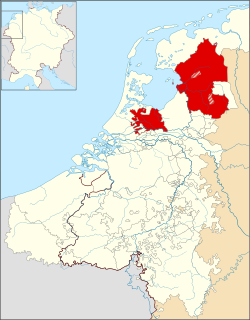
The Bishopric of Utrecht (1024–1528) was an ecclesiastical principality of the Holy Roman Empire in the Low Countries, in the present-day Netherlands. From 1024 to 1528, as one of the prince-bishoprics of the Holy Roman Empire, it was ruled by the bishops of Utrecht. The Prince-Bishopric of Utrecht must not be confused with the Diocese of Utrecht, which extended beyond the Prince-Bishopric and over which the bishop exercised spiritual authority.
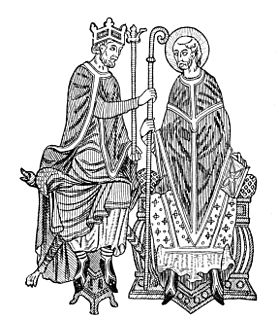
The Investiture Controversy, also called Investiture Contest, was a conflict between church and state in medieval Europe over the ability to choose and install bishops (investiture) and abbots of monasteries and the pope himself. A series of popes in the 11th and 12th centuries undercut the power of the Holy Roman Emperor and other European monarchies, and the controversy led to nearly 50 years of civil war in Germany.
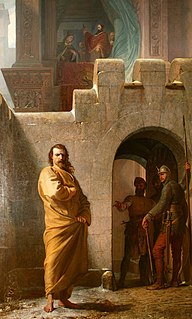
The Humiliation of Canossa,, sometimes called the Walk to Canossa or the Road to Canossa, was the ritual submission of the Holy Roman Emperor, Henry IV to Pope Gregory VII at Canossa Castle in 1077 during the Investiture controversy. It involved the Emperor journeying to Canossa, where the Pope had been staying as the guest of Margravine Matilda of Tuscany, to seek absolution and the revocation of his excommunication.
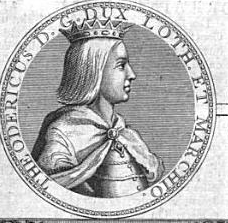
Theodoric II, called the Valiant, was the Duke of Lorraine from 1070 to his death. He was the son and successor of Gerhard and Hedwige of Namur. He is sometimes numbered Theodoric I if the Dukes of the House of Ardennes, who ruled in Upper Lorraine from 959 to 1033, are ignored in favour of the dukes of Lower Lorraine as predecessors of the later Dukes of Lorraine.

Simon I was the duke of Lorraine from 1115 to his death, the eldest son and successor of Theodoric II and Hedwig of Formbach.

Guibert or Wibert of Ravenna was an Italian prelate, archbishop of Ravenna, who was elected pope in 1080 in opposition to Pope Gregory VII and took the name Clement III. Gregory was the leader of the movement in the church which opposed the traditional claim of European monarchs to control ecclesiastical appointments, and this was opposed by supporters of monarchical rights led by the Holy Roman Emperor. This led to the conflict known as the Investiture Controversy. Gregory was felt by many to have gone too far when he excommunicated the Holy Roman Emperor Henry IV and supported a rival claimant as emperor, and in 1080 the pro-imperial Synod of Brixen pronounced that Gregory was deposed and replaced as pope by Guibert.
Bruno the Saxon was a German chronicler of the eleventh century and author of the Historia de Bello Saxonico or History of the Saxon Wars.
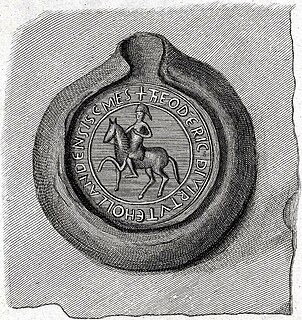
Dirk V was Count of Holland from 1061 to 1091.

Conrad was bishop of Utrecht between 1076 and 1099.

The Diocese of Toul was a Roman Catholic diocese seated at Toul in present-day France. It existed from 365 until 1824. From 1048 until 1552, it was also a state of the Holy Roman Empire.
Burchard of Basle, also known as Burkart of Fenis, Burchard of Hasenburg or Burchard of Asuel, was a Bishop of Basel in the eleventh century and a supporter of Holy Roman Emperor Henry IV (1056–1106).

The Synod of Worms was an ecclesiastical synod and imperial diet (Hoftag) convened by the German king and emperor-elect Henry IV on 24 January 1076, at Worms. It was intended to agree a condemnation of Pope Gregory VII, and Henry's success in achieving this outcome marked the beginning of the Investiture Controversy.

Benno II was Bishop of Osnabrück from 1068 until his death. He served as a close advisor and architect of Emperor Henry IV. In 1080 he founded the Benedictine abbey of Iburg Castle.

The 1086 papal election ended with the election of Desiderius, abbot of Monte Cassino as Pope Gregory VII's successor after a year-long period of sede vacante.
Benzo of Alba was an Italian bishop. He was an opponent of Gregorian reform who supported Henry IV of Germany in the Investiture Controversy.
Theoderic, or Thierry, was a royalist bishop of Verdun from 1047 to 1089. Before his consecration, he was a chaplain of Henry III.

Roland of Parma was an Italian cleric during the Investiture Controversy. He took the side of the Holy Roman Empire and served as the bishop of Treviso from 1073/1078 until 1089/1096.
The Synod of Brixen was a church council held on 15 June 1080 in the episcopal city of Brixen. It was convoked by King Henry IV of Germany at the height of the Investiture Controversy to pass judgement on Pope Gregory VII. The synod issued a decree condemning the pope, demanding his abdication and authorizing his deposition if he refused. The synod also elected his successor, Wibert of Ravenna.